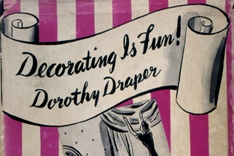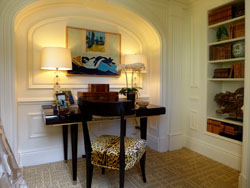Decorating Tips: Accessorizing in the Arts and Crafts Style
 Alexia Rossetti
Alexia Rossetti  Thursday, August 15, 2013 at 11:00AM
Thursday, August 15, 2013 at 11:00AM  Dragonfly vase, courtesy of Craftsman Touch
Dragonfly vase, courtesy of Craftsman Touch
Do you love decor with a crafts feel and the hand-made look? Then the Arts and Crafts style may be for you. The style was popular in the late 19th century and early 20th century and included the work of many popular designers and architects such as William Morris, Gustave Stickley, Frank L. Wright.
The features of Arts and Crafts included strong lines, stylized florals and insects, simple ornamentation, and employed materials such as wood, tile, stained glass and mica. Pottery - as seen above and below - was very popular. The Dragonfly vase and the Prarie Globe vase is from Door Pottery at Craftsman Touch.

Prarie Globe, courtesy of Craftsman Touch
 Bogt Clock, Frank L. WrightThe strong lines and use of plain wood is evident in Frank L. Wright's designs. The Bogt Clock and light fixtures reflect Wright's design motifs from his famous buildings. Wright incorporated these motifs into stained glass windows or doors.
Bogt Clock, Frank L. WrightThe strong lines and use of plain wood is evident in Frank L. Wright's designs. The Bogt Clock and light fixtures reflect Wright's design motifs from his famous buildings. Wright incorporated these motifs into stained glass windows or doors.
In the table lamps below, the first is from the Avery Coonley Playhouse; next to it is from the Robie House. Below that is from the Dana House and the Martin House.
 Light fixtures, Frank L. Wright
Light fixtures, Frank L. Wright
The use of tiles in home decor was also popular. Designers and homeowners hung welcome plaques in front of their homes. They also decorated the face and mantel of fireplaces with hand-made tiles.
 Motawi tiles, courtesy of Craftsman Touch
Motawi tiles, courtesy of Craftsman Touch
 Plaques, courtesy of Craftsman Touch
Plaques, courtesy of Craftsman Touch
Interested in learning more about accessorizing? Take a look at Sheffield School's Complete Course in Interior Design. At Sheffield, you will learn how to transform a space, create color schemes, and select furniture, lighting, and accessories.






















